Qianmen Street (前门大街) , located in the heart of Beijing, is a vibrant hub of history, culture, shopping, and dining. For centuries, it has been a gateway to the city and a must-visit destination for both locals and visitors. Whether you’re a first-time traveler or a seasoned explorer, this guide will help you uncover everything Qianmen Street Beijing has to offer. From its fascinating history to the best attractions, this guide covers it all.
1. Qianmen Street Overview
Qianmen Street spans 840 meters in length from north to south and 21 meters in width, showcasing the architectural elegance of the late Qing Dynasty. The street’s traditional buildings, adorned with grey bricks, red pillars, and ornate roofs, offer a glimpse into Beijing’s historical past.
Historically, Qianmen Street was a bustling commercial hub during the Ming and Qing Dynasties. Its strategic location near Tiananmen Square and the Forbidden City made it a vital part of Beijing’s trade and commerce. Despite numerous transformations, it has retained its cultural and historical significance.
Today, Qianmen Street blends the old and the new. Modern retail stores and cafes sit alongside traditional shops and eateries, creating a vibrant atmosphere. Visitors can explore ancient tea houses, traditional Chinese medicine shops, and trendy boutiques, capturing the essence of Beijing’s rich heritage.
2. How to Get to Qianmen Street
Reaching Qianmen Street (前门大街 Qian Men Da Jie) is straightforward, thanks to Beijing’s efficient public transport system.
By Subway
The most convenient way is via Subway Line 2, alighting at Qianmen Station (前门站). You can reach Qianmen Street by exiting from Exit C of Qianmen Subway Station. The station has a total of seven exits, and Exit C leads near to Qianmen Street and you’ll find yourself just a short walk away.
The operating hours of Qianmen Subway Station are from 5:16 AM to 11:28 PM daily. Visitors can plan their trips accordingly based on these timings.

Alternatively, Subway Line 7 serves the area, with Zhushikou Station 珠市口 (Exit A) in the southern end being another option.
Lastly take Subway Line 8 to Qianmen Station, exit from the southwest exit, and walk about 500 meters to reach your Qianmen Street.
By Bus
For those preferring buses, routes 22, 82, 137, 599, 67, 332, or Sightseeing Line 2 are viable choices, all stopping at Qianmen Bus Station. The ease of access makes Qianmen Street an ideal destination for travelers keen on exploring the heart of Beijing.
By Taxi or Ride-Share
Taxis and ride-share services like Didi can drop you off directly at the street. Simply provide the driver with the address Qianmen Street (前门大街), and they will know where to go.
On Foot
If you’re already exploring Tiananmen Square or the Forbidden City, Qianmen Street is just a 10-minute walk south. It’s a convenient addition to your itinerary.
3. Best Times to Visit Qianmen Street
The Best Times to Visit Qianmen Street
The best times to visit Qianmen Street are during spring (April to June) and autumn (September to November). These months offer pleasant weather, making it ideal for a leisurely stroll along the street. During the day, you can explore the shops, enjoy local delicacies, and admire the historical architecture in comfortable temperatures.
A Visit to Qianmen Street in the Evening
A visit to Qianmen Street in the evening is a magical experience. As the city lights up, the street transforms with vibrant neon signs and illuminated buildings, creating a captivating ambiance.
The night markets and eateries come alive, offering a lively atmosphere perfect for exploring and dining under the stars.
A Peaceful Morning Stroll on Qianmen Street
Wake up early and start the day with something special—watching the flag-raising ceremony at Tiananmen Square. The atmosphere is solemn yet inspiring, a must-see experience in Beijing.

Afterward, take a leisurely stroll down Qianmen Street. At this hour, it feels completely different from the bustling scene of last night. The crowds are gone, and the street is calm and peaceful. You can truly take in the beauty of its historic architecture and charming details.
Feeling hungry? Stop by a local restaurant for a classic Beijing-style breakfast. Savor a warm bowl of soy milk, crispy youtiao (fried dough sticks), or a piping hot jianbing (savory pancake). It’s the perfect way to fuel up for the day ahead.
With breakfast done, head to the north end of Qianmen Street and hop on a Beijing Tourist Bus to either Badaling or Mutianyu Great Wall. An exciting adventure awaits! What a perfect start to the day.
Different Seasons Bring Unique Charms to Qianmen Street
Different seasons bring unique charms to Qianmen Street. Spring blossoms and autumn foliage add natural beauty, while winter, though colder, offers a festive spirit with holiday decorations. Summer evenings are bustling with activity, making any season a great time to visit this historic street.
4. Stroll along the 845-meter long Street
Qianmen Street, stretching 845 meters from the majestic Zhengyangmen Tower to its southern entrance, offers a rich tapestry of Beijing’s cultural and historical heritage. As you walk down this pedestrian street, you will encounter a blend of traditional Chinese architecture and modern establishments.
The street is thoughtfully reconstructed to mirror its appearance in the 1920s and 1930s, creating an immersive historical experience that transports you back in time.

One of the street’s unique features is the harmonious coexistence of old and new. You will find Starbucks and other modern cafes nestled near traditional paifang gateways and ancient shops.
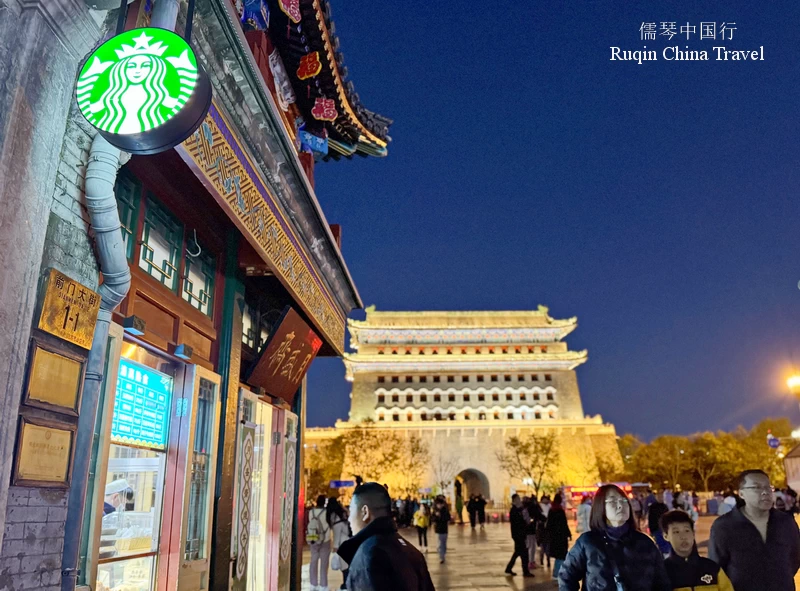
This fascinating blend makes Qianmen Street a perfect place to explore Beijing’s past while enjoying contemporary conveniences. The street’s design and layout have been carefully preserved, maintaining its historical charm.

Qianmen Street is home to over 80 historic shops offering a wide array of products, from traditional Chinese medicine and silk to tea and souvenirs.
Notable heritage courtyards and hutongs enrich the cultural experience, providing insights into Beijing’s history and traditions. Visitors can enjoy browsing through these shops, each with its own story and unique offerings.

The street is not just about shopping; it is also a vibrant hub of food and entertainment. Numerous eateries serve delicious local delicacies, from the famous Quanjude roast duck to traditional Beijing snacks. Street performances and cultural events often take place, adding to the lively atmosphere. Every step on Qianmen Street is a step through centuries of stories and traditions, making it a must-visit destination in Beijing.
5. Explore the Time-Honored Shops and Eateries Qianmen Street
Qianmen Street, rejuvenated before the 2008 Beijing Olympics, embodies Beijing’s cultural essence. The street is lined with time-honored Chinese brands, each with a rich history and unique offerings.
You can find traditional Chinese medicine at Changchuntang, a 200-year-old drugstore that merges Eastern and Western practices.

Food enthusiasts will be delighted by the culinary treasures along Qianmen Street. Quanjude, famous for its roast duck, offers a taste of Beijing’s iconic dish. Duyichu, with a legacy of over 250 years, serves traditional Beijing cuisine, providing an authentic culinary experience that reflects the city’s rich food culture.

Dong Lai Shun Mutton Hot Pot is a legendary dining spot on Qianmen Street, renowned for its authentic Beijing-style hot pot. Established in 1903, this historic restaurant specializes in tender mutton, thinly sliced and cooked in a traditional copper pot with glowing charcoal. The signature sesame sauce dip and fresh ingredients make it a must-try experience for food lovers. With its elegant decor and rich culinary heritage, Dong Lai Shun offers visitors a delicious taste of Beijing’s food culture right in the heart of Qianmen Street.

The blend of historic shops and modern eateries creates a dynamic atmosphere. Global retail giants sit alongside local favorites, offering a diverse shopping and dining experience.

Visitors can explore everything from traditional tea houses to trendy boutiques, making Qianmen Street a vibrant destination for both shopping and culinary delights.
6. Explore Dashilan: A Historic and Cultural Gem of Beijing
Dashilan Street (大栅栏), a historic commercial hub in Beijing, is just a short walk from the north entrance of Qianmen Street, branching off to the west. The total length from the east entrance to the west entrance is 275 meters.
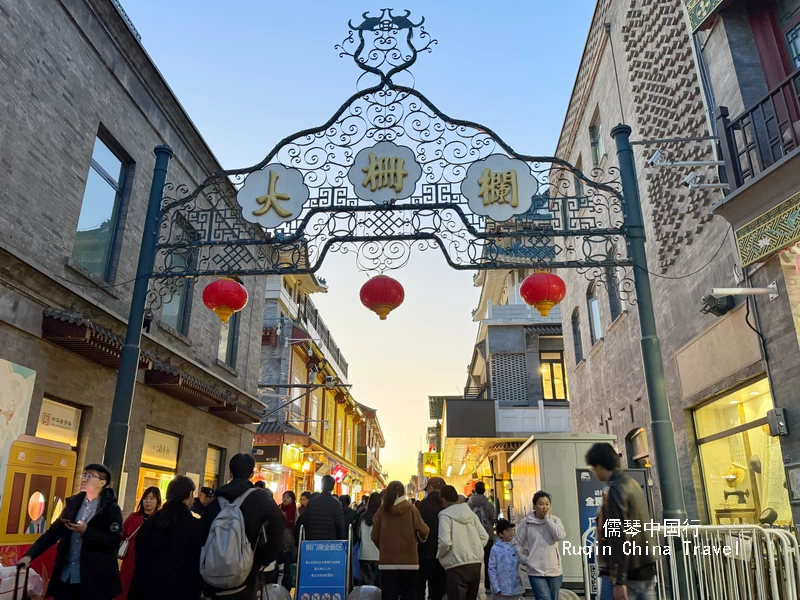
Dashilan Street, established in the 18th year of the Ming Yongle era (1420), evolved into a bustling commercial hub during the late Qing Dynasty.

Today, it stands as a gathering place for historical landmarks and some of China’s most iconic brands. The area is home to renowned establishments such as Guangdelou, Sanqingyuan (now part of the De Yun Society for traditional Chinese comedy), Zhengxingde, Tongrentang, Daguanlou, Ruifuxiang, and Liubiju.

Notably, Tianleyuan Theater, with its nearly 200-year history, has hosted performances by Beijing opera legends known as the “Four Great Dan Performers.”

Dashilan is a must-visit destination, offering a rich tapestry of Beijing’s history and culture. Here’s a detailed guide:
Top Attractions in Dashilan
- Dashilan First Street Museum: Explore the charm of traditional Beijing courtyards (siheyuan).
- De Yun Society: Sanqingyuan is a favorite spot for fans of Chinese stand-up comedy, especially Zhang Yunlei enthusiasts.
- Peking Opera Experience Hall: Dive into the world of Peking Opera with immersive activities.
- Daguanlou Cinema: The birthplace of Chinese cinema, blending history with modern entertainment.

Food Recommendations
- Wuyutai Tea Shop: Try their signature jasmine tea, ice cream, and tea-infused cookies.
- Imperial Crispy Beef Pastry: A delicious treat at only 12 RMB per piece.
- Fengnian Sausages: Crispy and flavorful, best enjoyed with garlic sauce.
- Sanyuan Meiyuan: Light and delightful desserts.
- Tianxingju: Famous for its traditional Beijing-style fried liver.
- Fangzhuanchang Zhajiangmian: Nicknamed “Beijing’s Michelin,” it’s a must-try for noodle lovers.
- Donglaishun: A hotpot paradise for mutton lovers.
- Sijiminfu or Bianyifang: Authentic Beijing roast duck at its finest.
- Tianfuhao: Known for its signature braised pork knuckle, a delicacy once served in the Qing imperial court.

Dashilan is an unmissable destination for history buffs, foodies, and culture seekers alike.
7. Explore Beijing Xianyukou Food Street
Beijing Xianyukou Food Street (鲜鱼口老字号美食街) is located at No. 40 Qianmen Street, conveniently just to the east of Dashilan Street. This bustling food street is open year-round. To fully experience its lively atmosphere and crowds, it’s recommended to arrive early and leave late.

Food Recommendations
Xianyukou Snack Street is a haven for authentic Beijing cuisine. Here are some must-try delicacies:

- Tianxingju: Known for its fried liver and fried sausages. The fried liver is packed with tender intestines, and the sausages are crispy on the outside and tender on the inside, best enjoyed with garlic sauce.
- Beiping Ice Factory: Offers traditional Beijing summer treats such as popsicles, yogurt, and various sodas at affordable prices.
- Bao Du Feng: Specializes in 13 cuts of tripe, including tripe tips and tripe cores, providing great value for money.
- Menkuang Hutong: A century-old shop famous for authentic stewed meat dishes at reasonable prices.
- Imperial Dairy: Features royal-style desserts and dairy snacks, especially their milk custard and double-skin milk.
- Jingfang Snacks: Famous for tangyuan (glutinous rice balls) and douzhi (fermented mung bean drink) at wallet-friendly prices.
- Xincheng Zhajiangmian: Serves traditional Beijing noodles with soybean paste and grilled meat skewers.

Travel Tips
Xianyukou Snack Street is a fantastic spot for photography. The street lights up beautifully at night, creating a vibrant and picturesque scene.
8. Riding the Qianmen Street Tram: A Short and Sweet Journey Through Beijing’s History
If you’re exploring central Beijing and want a charming, laid-back way to see one of the city’s most iconic streets, the Qianmen Street Tram is a must-try experience!

🕘 Operating Hours:
The tram runs daily from 9:00 AM to 9:00 PM, so whether you’re an early bird or catching the city lights in the evening, there’s plenty of time to hop on.
🎟️ Ticket Price:
A single ride costs 50 RMB, and kids under 1.3 meters tall ride for free — just keep in mind they’ll need to sit on a parent’s lap.
📏 The Ride Itself:
The tram travels along Qianmen Street, covering about 800 meters in total. It’s a short ride — around 10 minutes — but it’s packed with nostalgic charm, retro aesthetics, and a great view of this pedestrian-friendly, historically rich avenue.
Whether you’re resting your feet after a long walk or simply want to enjoy the old-timey clanging of the bell and classic architecture on both sides, this tram offers a fun and photogenic pause in your Beijing adventure.
9. Hotels in and around the Qianmen and Dashilan Areas
The ibis Beijing Qianmen Hotel is a budget-friendly option located in Dashilan near Qianmen Street. It offers clean and comfortable rooms with modern amenities, making it a great choice for travelers seeking convenience and value. Its central location provides easy access to popular attractions like Tiananmen Square and the Forbidden City.

The Qianmen area and its surroundings offer a charming mix of old-world Beijing and modern convenience. This district features a wide range of hotels, from traditional courtyard-style accommodations to contemporary luxury, providing a memorable stay with deep cultural immersion. Here are some recommended hotels in the Qianmen area of Beijing:
| Hotel Name | Brief Introduction |
|---|---|
| ibis Beijing Qianmen Hotel 宜必思酒店 | The ibis Beijing Qianmen Hotel is a budget-friendly option located in Dashilan near Qianmen Street. It offers clean and comfortable rooms with modern amenities, making it a great choice for travelers seeking convenience and value. |
| Chaoman Hotel (Beijing Tiananmen Square Branch) 潮漫酒店 | Chao Man Hotel is an international boutique hotel brand under the Plateno Group. The brand design is inspired by the concept of “the essence of the sun and moon, and water nurturing all things.” It is a chain of hotels filled with a stylish, romantic, and artistic atmosphere, offering a business and travel space that refines a sense of quality in the fast-paced lifestyle. Address: No. 21 Dashilan Street Phone: 010-63014688 |
| 北京天安门皇家驿栈 The Emperor Beijing Qianmen | The inn is located on the bustling Qianmen Street (Xianyukou Street) , surrounded by a complete range of dining, entertainment, and other amenities, offering convenient transportation. The inn features an elegant water-themed design, creating a serene and peaceful environment. Both guest rooms and public areas are equipped with wireless internet. The rooftop outdoor pool offers views of Beijing’s Qianmen and the CBD skyline. |
| 北京前门文华东方酒店 Mandarin Oriental Qianmen | One of the most luxurious hotels in Beijing. Located in the Caochang hutongs of the Qianmen East area, a 10-minute walk from Tiananmen Square. Features private courtyards and personalized high-end services. |
| 北京首都宾馆 Beijing Capital Hotel | A classic hotel located close to Qianmen and Tiananmen Square, known for its spacious rooms and reliable service. Ideal for business and leisure travelers. |
| 北京新世界酒店 New World Beijing Hotel | A modern, upscale hotel near Qianmen and Chongwenmen. Offers stylish rooms, excellent dining options, and a rooftop bar with stunning views of the city. |
| 北京前门建国饭店 Jianguo Qianmen Hotel | A comfortable and traditional-style hotel with a convenient location near Qianmen Street. Provides friendly service and a quiet atmosphere. |
| 桔子水晶北京前门酒店 Crystal Orange Hotel (Beijing Qianmen) | A trendy boutique hotel combining chic design with smart technology. Situated close to major attractions like Tiananmen Square and Qianmen Street. |
| 懿庭臻舍酒店(北京前门步行街店) Yitingzhenshe Hotel (Beijing Qianmen) | A boutique hotel offering a tranquil retreat in the lively Qianmen area. Features elegant decor and a mix of modern and traditional Chinese architecture. |
These hotels are conveniently located and cater to diverse traveler needs, from family-friendly stays to luxurious and boutique experiences.
10. Beijing Qianmen Street Tourist Bus Information
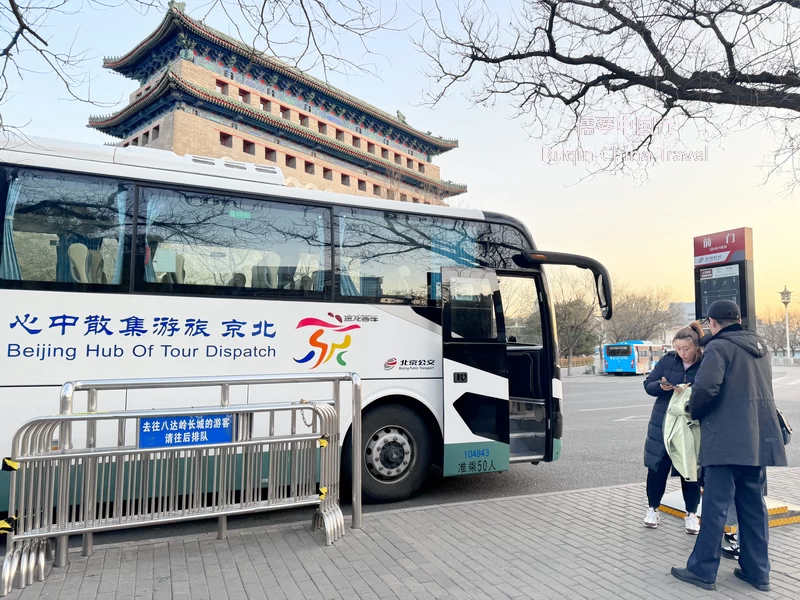
1) Badaling Great Wall Express Bus
- Departure Location:
- Regular stop: North entrance of Qianmen Street (opposite the south side of Zhengyangmen Arrow Tower).
- Departure Time:
- Regular hours: 7:30 AM – 11:00 AM, buses depart continuously.
- Return Time:
- Buses start returning from 12:00 PM, departing once full.
- Ticket Price:
- Round-trip fare: ¥80 per person.
- Some packages include entrance tickets (about ¥120 per person for round-trip bus + admission).
- Cable car tickets available for purchase on board at official rates.
2) Mutianyu Great Wall Express Bus
- Departure Location:
- Qianmen Tourist Distribution Center (30 meters south of Qianmen Station, Exit C, Metro Line 2).
- Departure Time:
- Peak season (holidays): 6:00 AM – 10:00 AM, buses depart continuously.
- Regular schedule: 7:30 AM, 8:30 AM, 9:30 AM, 10:30 AM, 3:00 PM (night tour gathers at 2:40 PM).
- Return Time:
- 2:30 PM, 3:30 PM, 4:30 PM, 9:00 PM (night tour).
- Ticket Price:
- Round-trip fare: ¥80 per person.
- Entrance tickets and cable car tickets available for purchase on board.
3) 🚍 The Grand Central Axis Daytime Sightseeing Bus: A Rolling Journey Through Beijing’s Historic Heart
Looking for a laid-back way to explore the beating heart of Beijing? The Grand Central Axis Daytime Sightseeing Bus takes you on a scenic ride from Qianmen to the Bell and Drum Towers, offering a front-row seat to some of the city’s most iconic landmarks — all without the hassle of walking the full route!

📍 Route Overview:
- Starting Point: Qianmen
- Final Stop: Bell and Drum Towers
- Distance: Around 12 kilometers
- No stops along the way — this is a non-stop sightseeing ride, so sit back and enjoy the journey!
🕰️ Operating Hours:
- 10:00 AM to 4:00 PM
- Buses depart once full, with a maximum interval of 30 minutes between departures.
🚌 What You’ll Ride:
Climb aboard a vintage-style Dangdang trolley, modeled after the classic trams of old Beijing — complete with nostalgic bells and wooden interiors!
🎟️ Ticket Info:
- 50 RMB per adult
- Children under 1.3 meters ride free, as long as they sit on an adult’s lap.
🎤 Onboard Experience:
Each tram features a live Mandarin-speaking guide, sharing fun facts and historical insights about the sites along the Central Axis — from imperial architecture to ancient towers.
This ride is perfect for first-timers who want a relaxed intro to Beijing’s historic layout or for anyone who just loves a good view from a comfy seat. It’s sightseeing the old-school way — and totally photo-worthy.
11. Nearby Attractions and City Walk
Qianmen Street is surrounded by some of Beijing’s most iconic landmarks and hidden gems. Just a short walk away is Tiananmen Square, a symbol of China’s history and culture. Nearby, you’ll find the majestic Forbidden City, where you can explore the imperial palace and its treasures.
Another nearby attraction is the Temple of Heaven, a historic site where emperors once prayed for good harvests. Each of these locations offers a unique glimpse into China’s rich heritage, making them must-visit destinations when exploring Qianmen Street.
If you have some extra time, don’t miss the hidden gem of Yangmeizhu Xiejie Street (498 meters long), just 100 meters west from Dashilan Street. This quiet, charming hutong (alley) offers visitors a rare glimpse into old Beijing. Unlike the busy commercial districts, Yangmeizhu Xiejie provides a peaceful retreat, rich in history, culture, and authentic local life.
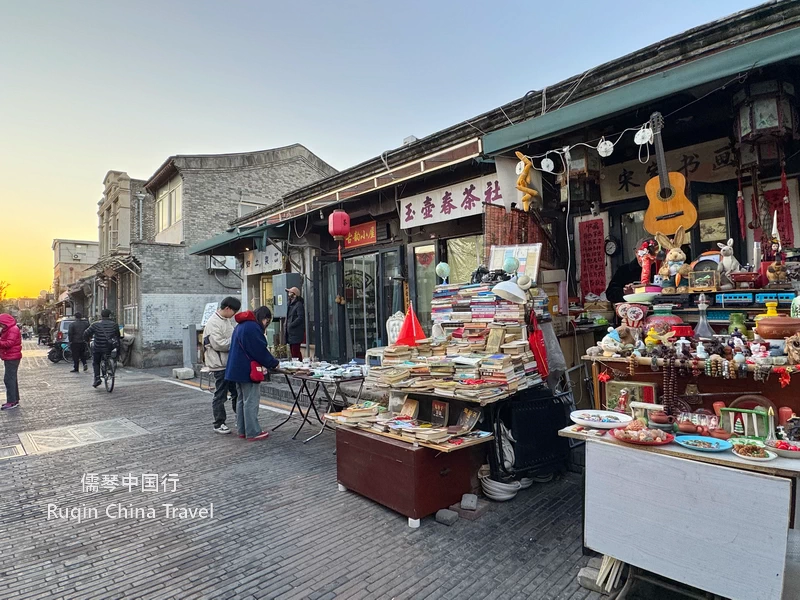
If you walk further to the west from Yangmeizhu Street, you will enter Liulichang Culture Street, a historic and vibrant cultural hub in Beijing, offers a unique and immersive experience for those interested in Chinese calligraphy, antiques, and traditional art.
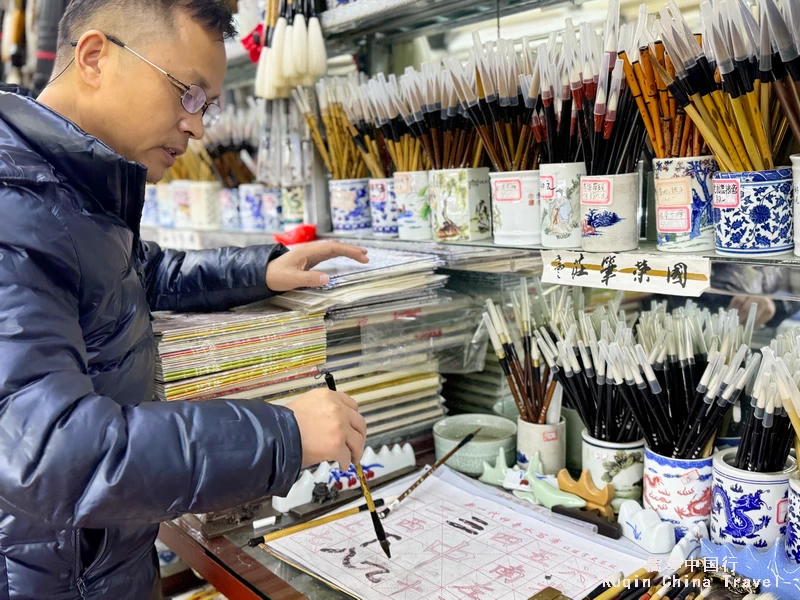
If you Walk from Xianyukou Street ( Qianmen ) to the east, you will soon reach Sanlihe Park, a peaceful oasis that offers a much-needed break from the fast-paced city life. Then go on to visit the nearby Caochang Hutongs, a hidden gem, offering a glimpse of authentic old Beijing life.

These well-preserved alleys are located near Qianmen and remain largely untouched by commercialization, making them an ideal destination for those seeking to experience Beijing’s true charm.
Practical Advice
- Language Barrier: While English is commonly used in major tourist spots, having a translation app or a phrasebook can be handy in smaller shops.
- Cash vs. Cards: While international credit cards are accepted in many stores, carrying some cash is advisable for smaller purchases, especially in the hutongs.
- Public Restrooms: They are available but vary in cleanliness. Carrying your own tissues and hand sanitizer is recommended.
- Footwear: Comfortable walking shoes are a must, as you’ll likely be on your feet for several hours exploring the area.
Safety Tips:
- Pickpocketing: Like any popular tourist spot, be mindful of your belongings. Keeping your valuables in a secure bag and being cautious in crowded areas is advisable.
- Pedestrian Safety: While on the street, stay aware of the sightseeing trams and other pedestrians
🌟Beijing Central Axis Discovery Tour
Qianmen Street • Tiananmen Square • Forbidden City
Embark on an unforgettable day exploring Beijing’s storied Central Axis — a grand line of history that reveals the soul of the capital. This expertly curated tour blends imperial heritage with lively street scenes, taking you from traditional hutongs to majestic palaces.
Let our experienced local guide lead you through centuries of culture, architecture, and national pride on this immersive full-day experience.
🔗 Book Your Beijing Central Axis Tour Now
✅ Tour Includes:
- Knowledgeable English-speaking guide
- Comfortable air-conditioned transportation
- All entrance tickets to listed attractions
As you plan your visit, remember the practical tips shared, respect the local customs, and most importantly, allow yourself to be immersed in the experience. Whether you’re a first-time visitor or a seasoned traveler, Qianmen Street promises new discoveries and cherished memories.
More Beijing Travel Guides
Planning your Beijing tour? Our “Beijing Travel Guide“ section offers essential advice to help you navigate the city like a pro. From transportation tips and local customs to insider recommendations for hidden gems, these travel tips will ensure you have a smooth, enjoyable, and unforgettable experience in China’s vibrant capital. Let us guide you through the best practices for exploring Beijing with confidence!



What time does it open and closes? Cos was planning to check this one out on my 15hrs layover
Hi Tish,
Qianmen Street is open 24 hours a day, basically not closed. But the best time to visit Qianmen Street in a day is from 9:00 am to 9Pm. Have a nice layover in Beijing!